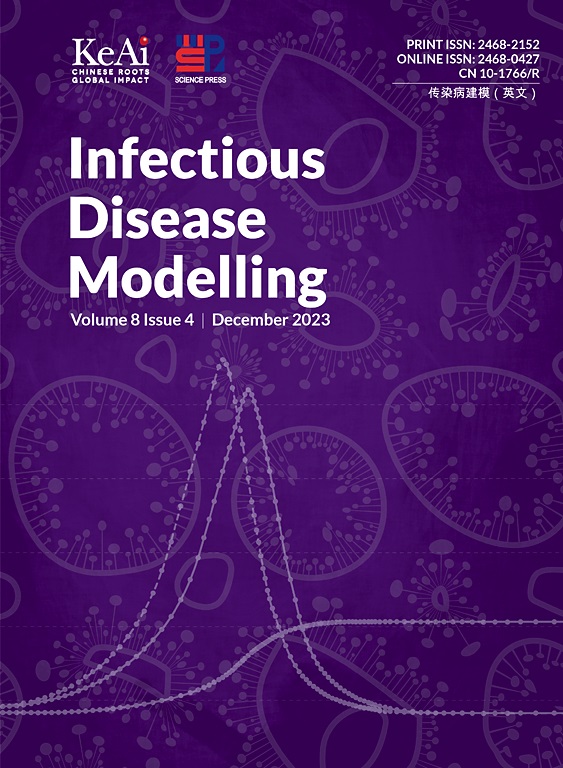A mechanistic modeling approach to assessing the sensitivity of outcomes of water, sanitation, and hygiene interventions to local contexts and intervention factors
IF 2.5
3区 医学
Q1 Medicine
引用次数: 0
Abstract
Diarrheal disease is a leading cause of morbidity and mortality in young children. Water, sanitation, and hygiene (WASH) improvements have historically been responsible for major public health gains, but many individual interventions have failed to consistently reduce diarrheal disease burden. Analytical tools that can estimate the potential impacts of individual WASH improvements in specific contexts would support program managers and policymakers to set targets that would yield health gains. We developed a disease transmission model to simulate an intervention trial with a single intervention. We accounted for contextual factors, including preexisting WASH conditions and baseline disease prevalence, as well as intervention WASH factors, including community coverage, compliance, efficacy, and the intervenable fraction of transmission. We illustrated the sensitivity of intervention effectiveness to the contextual and intervention factors in each of two plausible disease transmission scenarios with the same disease transmission potential and intervention effectiveness but differing baseline disease burden and contextual/intervention factors. Whether disease elimination could be achieved through a single factor depended on the values of the other factors, so that changes that could achieve disease elimination in one scenario could be ineffective in the other scenario. Community coverage interacted strongly with both the contextual and the intervention factors. For example, the positive impact of increasing intervention community coverage increased non-linearly with increasing intervention compliance. With lower baseline disease prevalence in Scenario 1 (among other differences), our models predicted substantial reductions could be achieved with relatively low coverage. In contrast, in Scenario 2, where baseline disease prevalence was higher, high coverage and compliance were necessary to achieve strong intervention effectiveness. When developing interventions, it is important to account for both contextual conditions and the intervention parameters. Our mechanistic modeling approach can provide guidance for developing locally specific policy recommendations.
一种评估水、环境卫生和个人卫生干预结果对当地环境和干预因素敏感性的机械建模方法
腹泻病是幼儿发病和死亡的主要原因。水、环境卫生和个人卫生(WASH)的改善历来是取得重大公共卫生成果的原因,但许多个人干预措施未能持续减少腹泻疾病负担。能够估计在具体情况下个别改善讲卫生行动的潜在影响的分析工具将支持规划管理者和决策者制定可产生健康收益的目标。我们开发了一个疾病传播模型来模拟单一干预的干预试验。我们考虑了环境因素,包括先前存在的WASH条件和基线疾病患病率,以及干预WASH因素,包括社区覆盖率、依从性、有效性和可干预的传播比例。我们说明了在两种可能的疾病传播情景中,干预效果对环境因素和干预因素的敏感性,这些情景具有相同的疾病传播潜力和干预效果,但基线疾病负担和环境/干预因素不同。是否可以通过单一因素实现疾病消除取决于其他因素的值,因此在一种情况下可以实现疾病消除的变化在另一种情况下可能无效。社区覆盖率与环境因素和干预因素均有很强的交互作用。例如,增加干预社区覆盖率的积极影响随着干预依从性的增加呈非线性增加。由于情景1的基线患病率较低(在其他差异中),我们的模型预测,在覆盖率相对较低的情况下,可以实现大幅降低。相比之下,在基线疾病患病率较高的情景2中,要实现强有力的干预效果,就需要高覆盖率和高依从性。在制定干预措施时,重要的是要考虑环境条件和干预参数。我们的机制建模方法可以为制定当地特定的政策建议提供指导。
本文章由计算机程序翻译,如有差异,请以英文原文为准。
求助全文
约1分钟内获得全文
求助全文
来源期刊

Infectious Disease Modelling
Mathematics-Applied Mathematics
CiteScore
17.00
自引率
3.40%
发文量
73
审稿时长
17 weeks
期刊介绍:
Infectious Disease Modelling is an open access journal that undergoes peer-review. Its main objective is to facilitate research that combines mathematical modelling, retrieval and analysis of infection disease data, and public health decision support. The journal actively encourages original research that improves this interface, as well as review articles that highlight innovative methodologies relevant to data collection, informatics, and policy making in the field of public health.
 求助内容:
求助内容: 应助结果提醒方式:
应助结果提醒方式:


